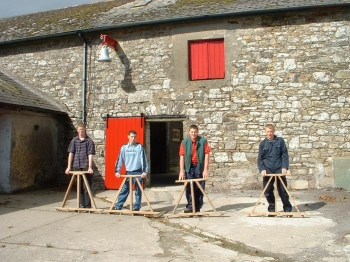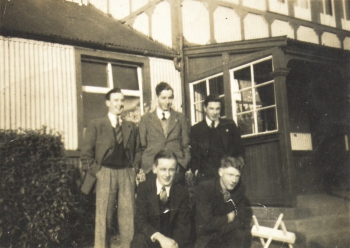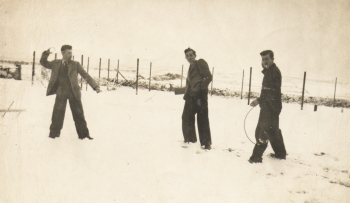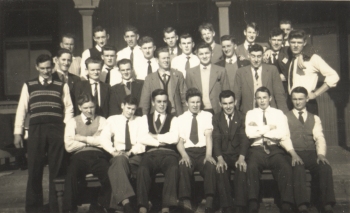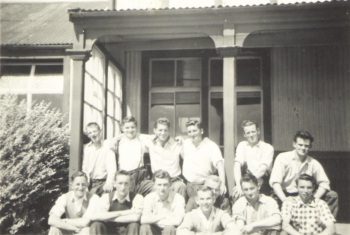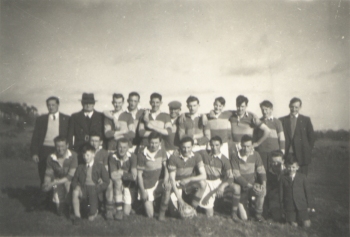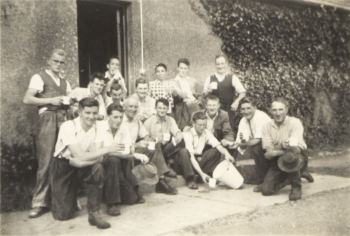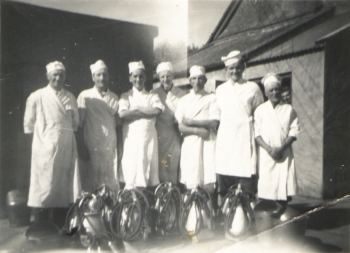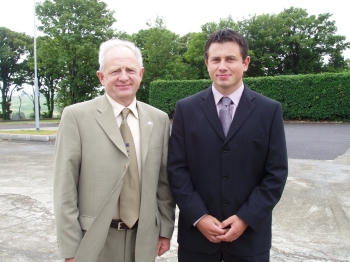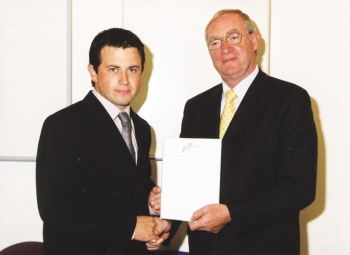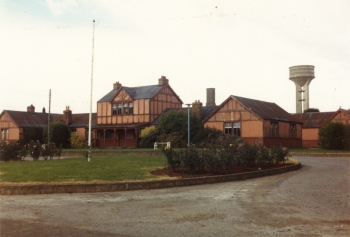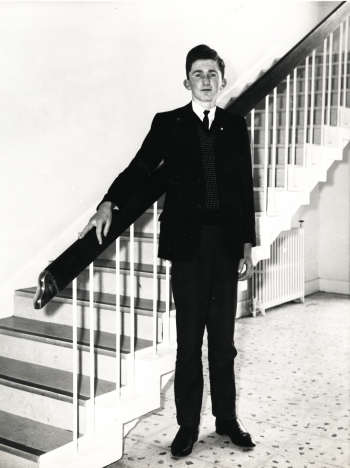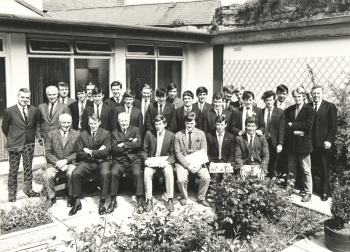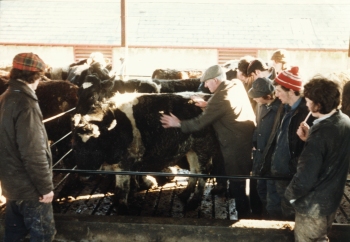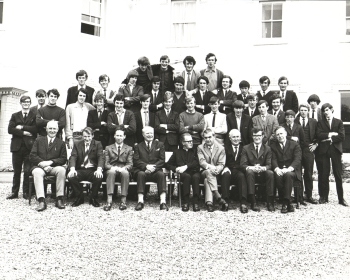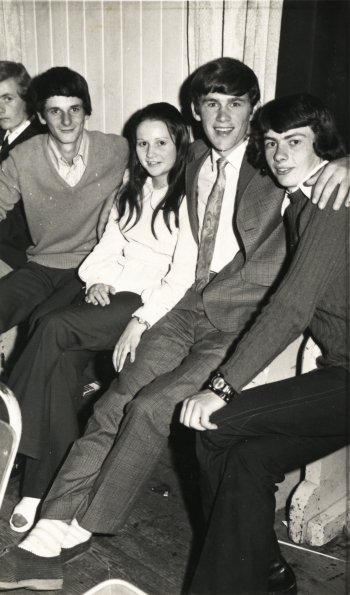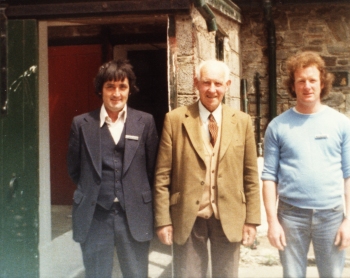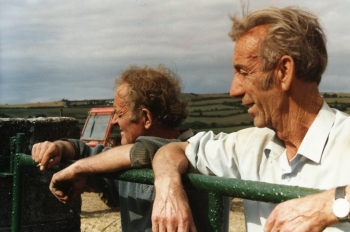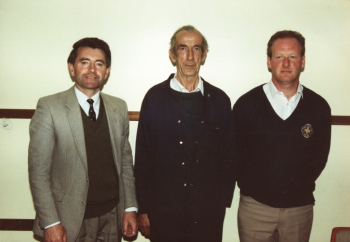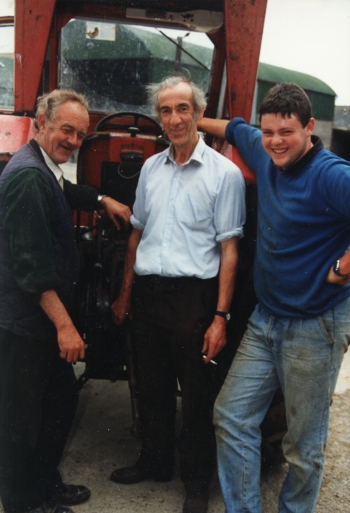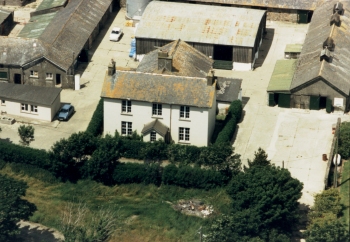1 February 2020
By Bryan Smyth
byran@TheCork.ie
Teagasc Clonakilty Agricultural College, also known as ‘Darrara College’ (prounced as Darra), has been involved in Agricultural education since 1905. The farm was given to the Irish State by trustees of the late Daniel O’Leary.
The site is made up of 140 hectares and provides a variety of courses in Agriculture. There are around 240 students currently registered. There is a balance of both school leavers (who gain entry via the CAO system on a CIT course) and mature participants among the students. Students are trained in the theory and practice of Agriculture and business and get an opportunity to work in a practical way on farms as part of their training
Below is a selection of photographs and writings which are organised chronologically.
Internal links
- 1905
- 192?
- 1927 – 1928
- 1936
- 1946 – 1947
- 1957 – 1958
- 1960
- 1961 – 1962
- 1962 – 1963
- 1965?
- 1966
- 1968 – 1969
- 1969?
- 1970
- 1970 – 1971
- 1973
- 1975
- 1977
- 1989
The West Cork People, Week Ending Saturday, August 26, 1905
Clonakilty Agricultural Station
Interesting Experiment – Teaching Young Farmers How to Farm The New Buildings at Darrara
(From our Special Commissioner).
When the newly-founded Agricultural and Technical Instruction Department of Ireland with Sir Horace Plunkett at its head, started on its career of reforming and improving the system of farming in Ireland, they did so under considerable, and we might say, vast difficulties. The Irish farmer, intensely conservative by nature, and wedded to the system of farm management handed down to him by his forefathers, was a difficult subject to deal with when it became a matter of introducing new features or foreign “notions”.
The system of itinerant instruction introduced at first was but an experiment. The idea, we take it, of this itinerant system, was to try to reach a class of farmer who, through age, nature, or other causes, would naturally be deprived of the opportunities of instruction of class or school. It was through that by sending round to the various localities qualified instructors in the various branches that advantage would be taken of the lectures and demonstrations on experimental plots by the adult farming population. Undoubtedly, a great deal of good was effected by the itinerant system of instruction, and many keen and intelligent farmers through out the length and breath of the land who attend the lectures acted on the hints received thereat, to-day feel themselves much the better for it financially. But there were the exceptions; The farmers, on the whole did not appreciate the lectures given by the instructors, of at least, they did not profit by them to the extent they should: The itinerant instruction system was, we regret, a failure. At all events, it did not give a suitable return for the amount of time, labour and money expended on it. The adult farmer was not being impressed by the system, and the young were not being reached or cultivated at all. It was through no fault of the County Cork instructors, who were all exceptionally gifted industries and intelligent officials. It was rather due to the negligence and indifference of the people themselves.
It was under these circumstances that a new departure was decided upon, or rather, a further development of the itinerant system. It was resolved to establish agricultural stations for the four Provinces, or rather, three, as the Glasnevin Model Farm serves as a station for Leinster. Stations have accordingly, been established at Ballyhase (Cavan), for Ulster; at Athenry (Mayo), for Connaught, and the one under notice at Darrara (Clonakilty), for Munster.
The situation of the station at Darrara is suitable and convenient, being about a mile and a half from the town of Clonakilty. The site is the farm of the late Mr. John Bennett, J.P, comprising some 340 acres. The circumstance connected with the eviction of Mr. Bennett from his holding are well-known through out the county, and need not be here re-told. The late Mr. D. O’Leary, of
Clonakilty, a most respected and influential merchant, having gone security in a large sum for Mr. Bennett, subsequently acquire possession of the farm a
Darrara, and managed it up to the time of his death.
By a secret trust in his will, the late Mr. O’ Leary devised the farm in trust to the Most Rev. Dr. Kelly, Bishop of Ross, and the Right Rev. Monsignor O’ Leary, parish priest of
Clonakilty. About six months ago, these last named gentlemen leased the farm and buildings to the Agricultural Department foe the purposes of an agricultural station; for which it is eminently intended.
The farm as we have stated is little over a mile from Clonakilty. The elevated site on which the farm residence and the new buildings stand, command a view of a wide stretch of country, and over look Ring Harbor, a quarter of a mile distant.
Mr. J.L. Duncan, formerly the Pioneer Lecturer of the Department, and who was for six months in charge of the Department’s exhibits at the Cork exhibition, has been placed in charged of the new station as Superintendent, and no better choice could have been made. Mr. Duncan is a practical agriculturist, who knows his business, and who has a happy knack of imparting his knowledge to others in a manner they can easily grasp.
At the station, experiments in connection with the breeding and feeding of live stock will be made, also experiments in tillage and dairying, tests in all branches of agriculture will be carried out. It is intended by the Department to admit to the station a number of young men as apprentices, whose education will consist largely in taking part under the direction of the superintendent in all the work of the farm, whether in connection with seasonable operations or permanent improvements. Practical instruction in the farm-yard, dairy, workshop and garden, will be provided in addition to work in the fields.
The literary portion of the pupil’s education will not be entirely neglected, as provision has been made in the evenings and at other leisure times for instruction in English, arithmetic (including surveying), book-keeping and technical agriculture. It is not intended that this instruction will have any reference to examination, as what will be principally aimed at will be to make the pupil’s sound, practical farmers rather than literary experts. The subjects taught, however, will be found useful to all young men who intend settling down as young farmers.
With regard to the age at which pupils will be admitted, it has been decided that they shall not be less than seventeen, but there is no restriction the other way. It will be made a condition of entrance that each pupil gives an understanding that it is his intention to become a farmer in Ireland. The would be emigrant who desires to qualify for a position in a foreign land will get no show here, and is not wanted. This is, however, a matter of which we do not altogether approve. A cynical acquaintance says that the Licensing Act of 1878 is responsible for a terrible lot of perjury. We feat the restriction above alluded to will be responsible for a great many broken promises. Indeed, personally, we believe that every young Irishman, whether he elects to stay in the country or not afterwards, is entitled to the very best education which his brains or resources can procure for him.
Another condition of entrance is that the applicant for admission must supply evidence of a certain prospect of becoming possessor of a farm on his own. Preference will be given to applicants from the province of Munster. It will be an advantage to the would-be student if, along with his application, he can send in a certificate from an itinerant instructor that he has attended lectures, and has assimilated the knowledge to be gained thereat, and has shown a wish to improve his knowledge of tillage farming.
Arrangements have been made for the proper housing and accommodation of thirty-two apprentices, who will be carefully looked after by a house master and matron.
It is proposed to open the session on the 17th of October next, and applications for admission will be received up to the 31st of August. The session will last for eleven months. Application for admission should at once be made to the Secretary, Department and Technical Instruction for Ireland, Upper Merrion Street, Dublin.
In arranging the scale of fees, the Department have been careful to see that the poor man’s son will not be handicapped, and the fees are fixed proportionate to the aggregate tonement valuation of the parent or guardian of the pupil. For instance, where the valuation does not exceed £20, the fee is only £3, where it exceeds £20, but not exceed £30, the fee is £5; where it exceed £30, but dies not exceed £75, the fee is £10; where it exceeds £75 it will be £15; all other apprentices £20.
A simple entrance examination in English and Arithmetic will be held, mainly with the pourpose of testing the suitability of candidates, for receiving class instruction.
Mr. Duncan kindly showed me over the station buildings, which are constructed of wood and corrugated iron, and are fairly substantial. The buildings consist mainly of class rooms, recreation rooms, spacious and air dormitories, with ample accommodation for the master and matron at their respective sides of the house; and also servants’ accommodation etc. The contract for the foundation was given to Mr. W. H. Jones,
Dunmanway, a good local firm, as was also the contract for the chimney shafts, sanitary arrangements, sewers, and plumbing. The entire contract given to Mr. Jones was for £300, and right good value he gave for the money. Mr. Jones has already executed a great deal of Government and public work in the south of Ireland. Spiers and Co., a Glasgow firm, and specialists in their own line, got the contract for the superstructure at £800.
In the course of conversation recently with Mr. Jones, he told me that this firm could undoubtedly do this class of work much cheaper than any Irish firm, as they made a speciality of it, so that Mr. Sloan’s attack on the Department for giving the contract outside of Ireland was hardly justified. Spiers and Co. made a very good of it, and the only regret is that a little more expense was not gone to, to provide a structure of stone and mortar, which would be more permanent. The woodwork is sheeted inside to prevent “condensation.”
With regards to water supply, there will be some trouble, as it will be necessary to pump water from a lower level, up to the higher parts on which the building stand. The sewerage will be pumped out for the irrigation of the land.
The Department’s engineer gave great credit to Mr. Jones, for the manner in which he completed his work, which he did expeditiously and well. He employed none but local labour in the work. The Scotch firm, for obvious reasons, brought all of their men from Scotland. The whole of the building were run up in three months.
In the interval between Mr.D.O’Leary’s death, and taking over the place, by the Department the farm was managed in an exceedingly able and intelligent manner by
Mr, Jerome Holland. He kept the very best live stock and in every other way kept the farm and buildings up to date. He deserves every credit for the manner in which he managed the estate. Had he not done his work so well it is doubtful if Darrara would have been then the site selected, so that really the people of Clonakilty who will naturally benefit by having such a “station” in their midst will be gainers by Mr. Holland’s efficiency.
The station buildings, which are two story, have a full view of the broad Atlantic; and the passengers on board the American liners can be seen from the premises, almost without the aid of a glass, while the buildings themselves look very showy and imposing from a distance.
This year Mr. Duncan has talked about a hundred tons of hay off the holding. This is now well saved and stored in the extensive hay sheds erected by the late Mr. D. O’ Leary. He has also thirty acres of oats of good quality, which crop is already harvested; also a quantity of potatoes. The lands, he thinks, will not be suitable for the growing of the early kinds of potatoes, but he can see what he can do in this direction in future seasons.
One important and useful function that the station will perform, will be the distribution of good seed amongst the farmers of the locality. Needless to say that this should have a great influence on the quantity of the future crops of the district, whilst Mr, Duncan will be ever at hand and willing to give any information or suggestion on matters connected with the cultivation of the land.
The Darrara Agricultural Station will also be well supplied with the latest and most up-to-date machinery foe farming purposes. On the occasion of my visit I was shown a fine machine for hay-making, which would the work of fifteen hands, or 25 acres in a day. Another useful and ingenious machine shown to me was a “rick lifter,” which could raise a “rick” or hay cock of fifteen cwt.
The farm holds at present 126 heard of cattle, including 40 milch cows, and 31 calves. There are 150 Border Leicester Sheep and 40 pigs. In the programme of education laid out by the Department for the apprentices, a practical knowledge of dairying will form an important feature.
In regard to milch cows, Mr. Duncan only believes in keeping the best, as poor milkers are really only a source of loss, and should be got rid of without delay. They do not pay for their keep.
The other live stock on the farm includes a splendid bay stallion. This horse was bread by Lord Rosebery, and was foaled in 1899. He stands 16 hands high 1 inch, and is by Orme out of Serpentine, by St. Serf gelding, Footlight by Creinorne gelding. Paraffin by Blair Athol. Farmer’s mares are served by this stallion at a fee of £3.
There is also at the station a fine Spanish jack ass, which during the past season has been let for service at 2s 6d.
In the course of an interesting conversation with Mr. Duncan, he dwelt on the great importance of using good and suitable manures, and said that much of the money spent on the purchase of artificial manures was lost, owing to the want of knowledge of the proper kinds to apply to the land.
I came away from Darrara much impressed with all I had seen and heard during my brief visit, and felt confident that there was a great future in store for the district, which was to have in its midst such a useful and instructive institution. Truth to tell, I felt a little envious of the young men, who would have such advantages placed before them for little or noting – advantages, which I or my contemporaries could never have even dreamed of, in our sadly neglected youth. Will the youth of Munster rise to the occasion and seize the opportunity now afforded them of becoming expert and successful farmers, able to meet in competition with the foreigner. Time will tell.
A few weeks ago, Sir. Horace Plunkett, the Most Rev. Dr. Kelly and the Right Rev. Mgt. O’ Leary, paid a visit to the station, and after a close inspection of the farm and premises, expressed themselves well pleased with the condition in which they found everything.
192?
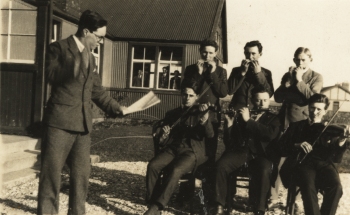
Making Music
The photograph was taken in the year that Dan Joe was a student,
192?
(Source: Michael Nunan, Former College Superintendent)
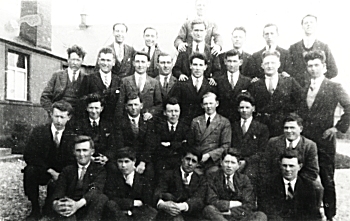
Class of 1927 – 1928
(Source: Michael Nunan, Former College Superintendent)
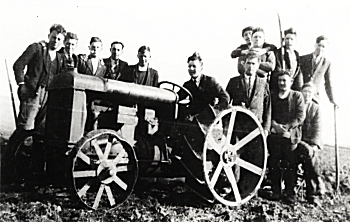
An Early Tractor
Joe Ryan is fourth from the left(Source: Michael Nunan, Former College Superintendent)
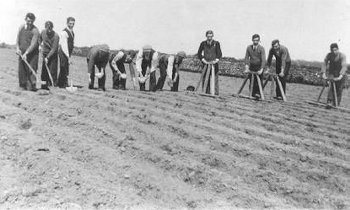
Hand sowing of sugar beet in 1936 at Clonakilty Agricultural College
There were no precision sowers of beet in 1936. The “dibblers” are on the right with the sowers of the seed from basins in the centre and followed finally by the closing of the dibble holes with the shovels by the group on the left. William Winter is the student in the centre of the shovel group. The fourth shoveller is missing because he was the photographer.
Dibblers at the College in 2003
Tadgh O’Connell, Watergrasshill, Thomas Tobin,
Castlelyons, Billy Curtin, Charleville, Seamus Cusack, Charleville.
The five lads from Limerick
Left to Right: back row: Tim Humphries, Murroe; Joe Daly, Lough Gur, Bruff;
Joe Hartnett, Abbeyfeale; front row William Baggott, Herbertstown; Tom Ryan, Croom.
(Source: Joe Daly, Navan, Co Meath, 28/06/02)
Snow, Winter 1947
Left to Right: John O’Connell, Ovens, Co Cork; Joe
Daly, Lough Gur, Co Limerick; Tim Foley, Killorglin, Co Kerry, throwing snowballs in front of the College.
(Source: Joe Daly, Navan, Co Meath, 28/06/02)
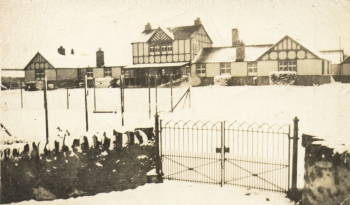
Snow, Winter 1947.
The College with the lawn and tennis court
covered in snow.
(Source: Joe Daly, Navan, Co Meath)
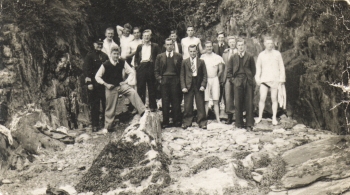
The “Cool”, Summer 1947
A group of students accompanied by a Garda
Sergeant swimming at the “Cool” past Ring
village. Joe Daly is third from the left, at the
back still in togs. Four from this group including Joe Daly went on to Albert College the following
year.
(Source: Joe Daly, Navan, Co Meath)
Class of 1957 – 1958
Front row, left to right: Christy McCarthy, Gerard Tiernan, John
Doyle, Michael Walsh, Felix O’Neill, Donal O’Shea, Tony Mannion.
Middle row, left to right: Eddie Brett, Andrew Vaughan, Philip
Chambers, Nicholas Byrne, JG Roberts, John Drummey.
Back row, left to right: Richard Butler, Donal Feeham, PJ
Collins, Tom Lynch, John Randles, Donal Griffin, Jack Lynch,
Gerard Quinlan, Paddy Leader, Jerome Geaney, John Verling,
Andrew Brennan, Danny O’Driscoll, Patrick Quigley.
Absent: Paddy Maher.
(Source: Jerome Geaney)
Class of 1957 – 1958,
pictured at front entrance, Summer 1958
Front row, left to right: Richard Butler, PG Collins.
Donal Griffin, Jack Lynch, Tony Mannion, Donal O’Shea.
Back row, left to right: Paddy Leader, JG Roberts, Danny
O’Driscoll, Jerome Geaney, Nicholas Byrne, Thomas Chambers.
(Source: Jerome Geaney)
Darrara GAA Team, in 1958 West Cork Championship
Back row, left to right: Peadar Fitzgerald, Frank Doran, John Murphy (Housemaster) at far right.
(Source: Jerome Geaney)
Evening Tea, at the Dairy door, Summer 1958
Front row, left to right:
JG Roberts, Danny O’Driscoll, Mick Dwane (farm
manager), Tony Mannion, Nicholas Byrne (having tea), Paddy
Leader, Jerome Geaney, Ger Brennan (workman).
Back Row, left to right: Paddy Maher, Thomas Chambers, PG
Collins (at back), Jack Lynch, Donal Griffin, Donal
O’Shea, Donal Derling (staff), Jim O’Sullivan (workman).
(Source: Jerome Geaney)
Ready for milking,
Summer 1958
Left to right: Mick Kirley (herdsman),
Jim O’Sullivan (workman), Jerome Geaney (student), Paddy
Leader (student), Ger Brennan (workman), JG Roberts
(student), Michael Walsh (workman).
(Source: Jerome Geaney)
1960
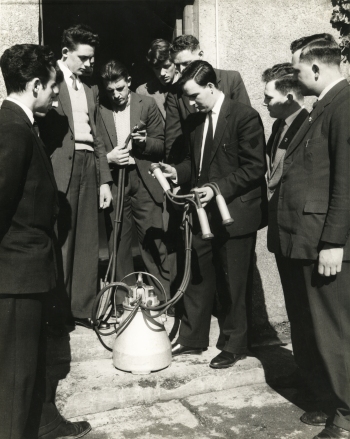
Dairy class, 1960
(Image: TA Bluett)
1961 – 1962
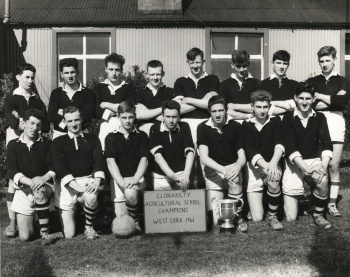
Clonakilty Agricultural School Champions West Cork, 1961
(Image: TA Bluett)
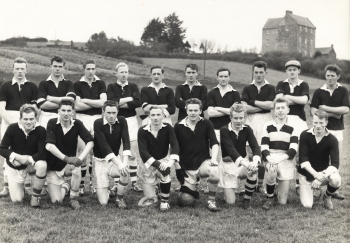
Student team 1961 – 1962
(Image: TA Bluett)
Father and Son May 2004
Left to right: Past Student John B Carey (1962 – 1963)
with son Denis Carey (2004) of Derrylugga, Skibbereen, Co Cork.
Skibbereen.
Denis Carey 2004
receiving his Certificate from Joe Walsh, TD, Minister for Agriculture and Food.
College Building
Since demolished.
Cork Examiner, Friday, January, 1966
Minister Opens New College at Darrara
The Minister for Agriculture and Fisheries, Mr. Haughey, opened the new Agricultural College buildings at Darrara, Clonakilty, yesterday, after they had been blessed by Right Rev. Mgr. J. Barrett, P.P. V.G., Clonakilty.
Mr. Haughey said, “Clonakilty has been a centre of agricultural education for over 60 years. The Clonakilty Agricultural – or Darrara, as it is better known locally – which was set up in 1905 by the newly established Department of Agriculture and Technical Instruction, owed its origin to the system of agricultural education that was then being initiated by Sir Horace Plunkett, the Department’s guiding spirit”.
“That system provided for the holding of evening classes in agricultural each winter at selected centres in each county. The best students at the classes were to have opportunity in agriculture by attendance at residential Agricultural Schools, one of which was to be set in each province”.
“Clonakilty was chosen as the location of the school for the province of Munster”.
“In the years which have elapsed since the college here was founded, Clonakilty has won for itself a high reputation in agricultural circles, resulting from the high standards of performance and maintained by the generations of students who passed through the college.
“We are today to mark the replacement of the old structure by the splendid new building which has now been provided. The old building was erected as a temporary structure to be replaced at an early date. As you can see, it is still standing – a testimony to the truth of the French proverb ‘nothing is permanent except what is temporary’.
First Student in New College, 1965
A student stands for a photograph in late 1965. The College
opened in 1966.
Class of 1968 – 1969
Front row, left to right: M
O’Flaherty, E Kirby, F O’Connell, A Hallahan
Middle row, left to right: J Meade, MP O’Donoghue, D
Brassil, J McSweeney, T Ceaser, J Herlihy, C Spillane, M
Guiry, L Ryan.
Back row, left to right: P Kennedy, T Walsh, M Dillane, D
O’Brien, J O’Donoghue, P Fullam, R Cuffe, T Keane.
Absent: D Kinsella, J O’Sullivan, T Shannon, PJ Coffey
1969?
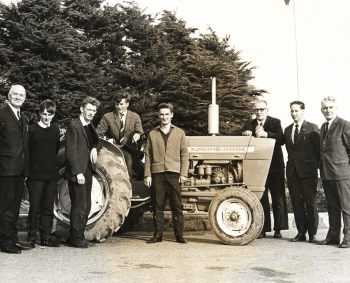
A New Ford 3000
Front row, left to right:
Dermot Kelleher, ?, ?, ?, Tom Power, ?, Michael Nunan, Gerry McGovern (Tractor
Manager Ford Motor Company)
(Source: Michael Nunan, Former College Superintendent)
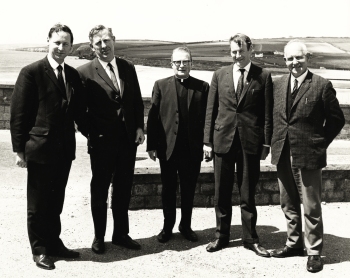
Dunmore?
June 1970
Front row, left to right: ?(Text: Michael Nunan, Former College Superintendent)
(Image: John F McCarthy)
Beef Scoring Mick Dwane with Students 1970
Class of 1970 – 1971
Front row, left to right: P Sullivan, D O’Connor, J
Hehir, D Walsh, M Kenneally, T Murphy, A Byrne, G Brennan,
M Hayes, M Leary, D Sheehan, T Crowley, D Sheehy, D
Kennedy, M Ferris, S Murray, J O’Sullivan, M Quinn.
Middle row, left to right: F O’Regan, M Lehane, T
Lonergan, P Martin, J Hallissey, M O’Brien, F Ratigan, T
Casey, J Russell, K O’Neill.
Back row, left to right: M McCarthy, J Cadogan, M
O’Mahony, S O’Leary.
College staff & Past students, 1973
Left to Right: John Kehoe (Poultry Unit), Carmel
O’Regan (Chef), Maurice Leahy (Stockman), Con O’Sullivan
(Dairy Stockman).
1975
Left to Right: John O’Donoghue (Beef/Sheep Stockman),
Mick Dwane, John F Murphy (Dairy Stockman)
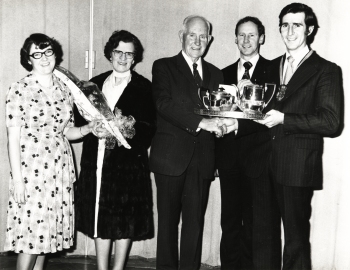
Retirement of Mick Dwane after 50 years of service
Left to Right: Bernadetta Nunan, Mrs Dwane, Mick Dwane
(Farm Foreman), Micael Nunan (Superintendent), Frank Shaw
August 1989
Left to Right: Jackie Keohane, Jim Calnan
1989?
Left to Right: David Collins (College Principal), Jim
Calnan (Tractor Driver), John F Murphy (Shop Steward/Stockman)
Tractor Crew
Left to Right: Jim Calnan, Jackie Keohane, Con Hurley
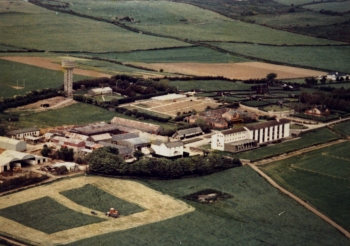
Aerial photograph
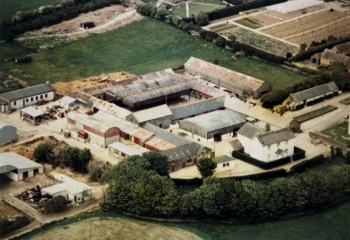
Aerial photograph
Superintendent’s House


